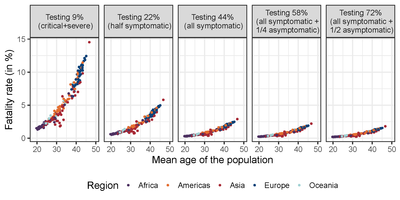How many lives can be saved?
A global view on the impact of testing, herd immunity and demographics on COVID-19 fatality rates
In this work, we assess the global impact of COVID-19 showing how demographic factors, testing policies and herd immunity are key for saving lives. We extend a standard epidemiological SEIR model in order to: (a) identify the role of demographics (population size and population age distribution) on COVID-19 fatality rates; (b) quantify the maximum number of lives that can be saved according to different testing strategies, different levels of herd immunity, and specific population characteristics; and (d) infer from the observed case fatality rates (CFR) what the true fatality rate might be. Different from previous SEIR model extensions, we implement a Bayesian Melding method in our calibration strategy which enables us to account for data limitation on the total number of deaths. We derive a distribution of the set of parameters that best replicate the observed evolution of deaths by using information from both the model and the data.
Team: Vanessa di Lego, Miguel Sanchez-Romero, Alexia Prskawetz
Research Group: Economic Demography, Health & Longevity
Cooperation Partner: Universidade Federal de Minas Gerais, Cedeplar, Brazil - Bernardo L Queiroz
Time Frame: March - July 2020
